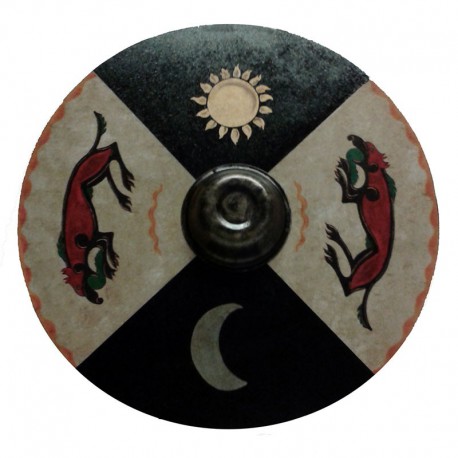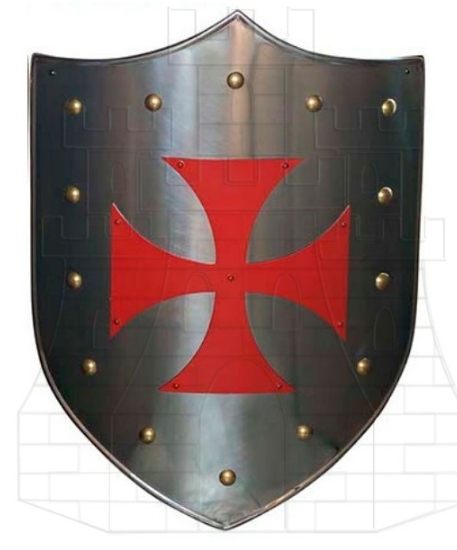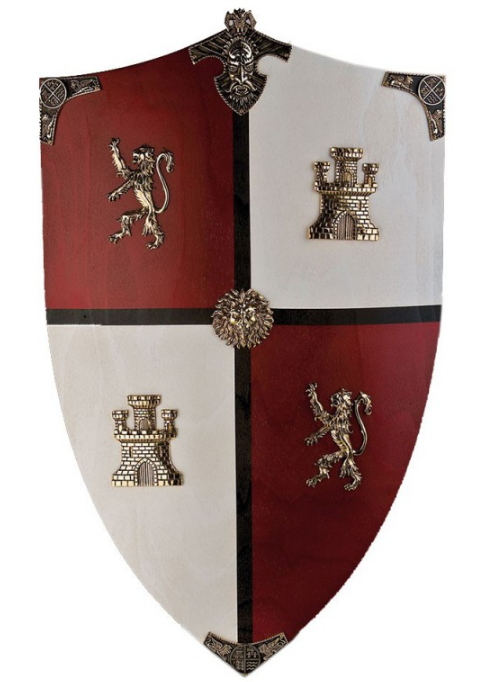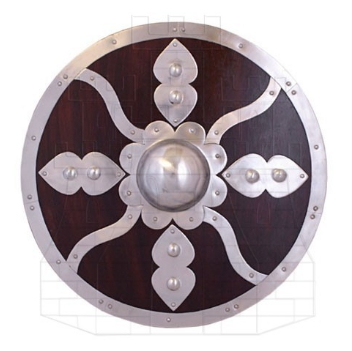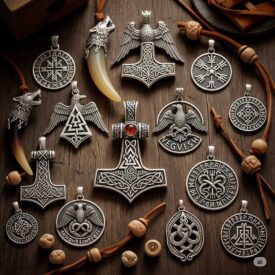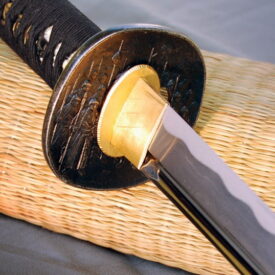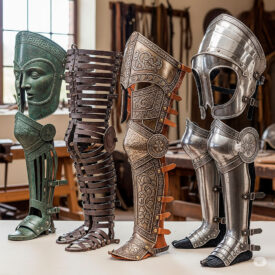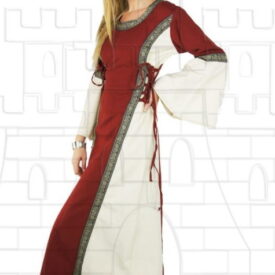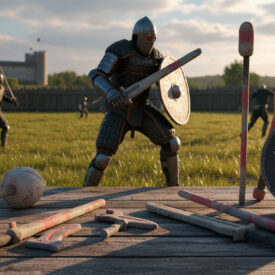The most representative shields and rondaches from all eras will always surprise us, for these weapons of defense and attack have been used by mankind since antiquity and have been crafted from every possible material, from wood and leather to bronze, iron, and steel. The common element of shields is their versatility in both close combat and at a distance, and how they protect the fighter from thrown or wielded weapons like swords.
The shield, one of the oldest defensive weapons, has been a fundamental element in combat and a powerful cultural symbol throughout history. From its origins in the 3rd millennium BC in Sumerian civilization, through its evolution on the battlefield, and its enduring use in modern settings such as riot police, the shield has shown remarkable adaptability in terms of materials, shapes, and functions. Beyond its primary purpose of protecting the combatant, the shield has served as an expression of values, beliefs, social status, and military strategies across civilizations.
Main Function and Combat Tactics
The main purpose of the shield has always been the physical protection of the combatant from direct blows, edged weapons, polearms, and projectiles. However, its role transcended mere defense, becoming a key component in battle tactics that defined entire conflicts.
Individual and Collective Use
Shields could be light and small for individual duels, prioritizing mobility and quickness, such as the buckler or rondache. These designs allowed agile defense and rapid attacks. On the other hand, shields like the Roman scutum or medieval pavises were large and provided extensive coverage, enabling group defensive formations. The “shield wall” (skjaldborg for the Vikings) was a crucial tactic where warriors stood shoulder to shoulder, overlapping their shields to create an impenetrable barrier. The famous Roman testudo is another example of a shield formation for near-complete coverage.
The Shield as an Offensive Weapon
Although primarily defensive, the shield could also be used to strike, disarm, or unbalance the opponent. In some cultures, its edges were reinforced with metal to increase its offensive capability. The umbo, the metal boss in the center, not only protected the hand but could be used to deflect weapons or even as a striking weapon.
Tactical Evolution
The evolution of the shield was directly linked to advances in technology and military tactics. For example, the introduction of the oval, curved shield in Rome at the end of the 3rd century BC “shows us how Roman combat tactics evolved into tighter formations.” (THE ROMAN SHIELD), demonstrating that shield design was a direct response to the changing needs of the battlefield.
Materials and Manufacturing: The Engineering Behind Protection
The materials and manufacturing techniques of shields varied greatly across time and cultures, adapting to available resources and combat needs. The choice of materials was crucial to balance protection, weight, and durability.
Common Materials
- Wood: This was the main component for most shields. Woods such as linden (for its lightness and malleability, especially in Viking shields), fir, alder, poplar, birch, and oak (harder and heavier) were used. Shields were constructed from glued strips or planks of wood, often layering several perpendicular layers to increase strength.
- Leather/Hide: Used to cover the outer surface of the wood, providing extra protection against moisture and increasing durability. Techniques like “boiled leather” (cuir bouilli) could harden it almost to the toughness of metal.
- Metal: Used for reinforcements and specific parts, such as the umbo and the edges. By the end of the Middle Ages, fully metal shields emerged, which offered superior protection but were heavier and more expensive.
The Shield as Canvas: Symbolism and Heraldry
Beyond its practical use, shields acquired profound symbolic value, acting as canvases that told a story about the warrior or their lineage.
Identification and Loyalty
Warriors decorated their shields with colors, symbols, or emblems to be recognized in battle and to reflect their beliefs, loyalties, and aspirations. The Romans, for example, used “specific colors and symbols on their shields to indicate legion identity.” (Infobae). Similarly, Vikings painted their shields with “simple spirals or geometric patterns” and sometimes “more elaborate depictions of mythological creatures” to intimidate their enemies.
Medieval Heraldry
In the Middle Ages, shields evolved to become emblems of lineage and honor, serving as the primary “canvas” for heraldic representations. Coats of arms “told of their exploits and lineage” (Battle-Merchant, Medieval Shields). The triangular shield, in particular, “played a crucial role in the development of heraldry” thanks to its compact shape, ideal for concise and striking designs.
Types and Shapes: A Journey Through the History of Shields
No famous warrior was without a characteristic shield among their weapons. For this reason, we present the shields of the bravest fighters of each historical moment, showing how their shapes adapted to the specific needs of battle.
Celtic Shields
Let’s begin with the shields of Celtic warriors, made of wood and sometimes round or oblong, with an elongated wooden umbo. They were robust and functional, suited to their individualist combat style.
Shields of the Greek Hoplites
Among the shields of Greek warriors, the most admired are probably those of the hoplites. The aspis was a circular, large, and heavy shield, designed for fighting in a phalanx or “shield wall,” with a complex grip that distributed the weight and allowed warriors to come together in a formidable barrier.
The Roman Scutum
The most outstanding Roman Scutum was the turtle shield used by Roman legionaries as a shell to advance while protecting themselves from enemy spears and arrows. It was very large and semi-cylindrical, made of layers of wood and covered with canvas and leather, making it exceptionally sturdy and adaptable to legion tactics.
Round Viking Shield
Another emblematic shield is that of the formidable Viking warriors. These were round with a strong central boss protecting the hand. Their size matched the warrior’s body size and fighting style, ideal for one-on-one combat and “shield wall” formations.
Shield of the Templar Knights
The most significant shield of medieval chivalry is that of the Templar Knights, with its unmistakable red cross or the symbol of two knights riding a single horse. These shields, often triangular or “teardrop-shaped,” were not only weapons of protection but also powerful symbols of faith and honor.
Shield of El Cid Campeador
Among medieval shields, many were owned by famous kings, nobles, and warriors, so choosing just one is difficult, but perhaps the most famous is the shield of El Cid Campeador. Its heraldic design and the symbolism of his deeds make it an icon of Spanish history.
Decline and Legacy in Modernity
The prominence of the shield began to fade with improvements in personal armor and the advent of firearms. The widespread use of arquebuses and muskets rendered traditional shields “largely useless,” as they could no longer stop projectiles as effectively. As its battlefield utility declined, shields became ceremonial objects and carriers of heraldry.
However, despite disappearing from traditional battlefields, the concept of the shield persists. The “legacy of medieval shields is clearly evident in modern heraldry.” Coats of arms continue to be used in national emblems, military logos, institutions, and sports clubs, keeping alive their meaning of protection and authority. In a more practical sphere, modern plastic or composite “riot shields” are direct heirs of their predecessors, replicating “Roman tactics” to maintain the line and protect officers.
Among the most famous shields in history, you can choose between decorative and functional shields. The former serve to beautify and decorate thanks to their beauty and design, while the functional ones are not only beautiful but above all strong and resistant, made of special materials, suitable for fighting in medieval combat or for reenactors. Either one is also an exceptional piece for collectors. This one we show you is a functional Viking shield made of wood and steel, with a firm grip on the back:
The shield is a tangible testament to the evolution of war and society. From its humble beginnings as a simple defensive barrier, it transformed into a complex object of craftsmanship and symbolism. Its history reflects the constant interplay between the need for protection, technological innovation, combat strategies, and cultural expression. Although its direct military function has been surpassed by advancements in weaponry, the shield endures in the collective imagination and in modern applications, reminding us of its profound historical and cultural significance.
If you are passionate about the history of these formidable defensive weapons and want to acquire a functional or decorative piece for your collection or reenactment, we invite you to explore the wide variety of shields and rondaches from all eras that we have selected for you.


